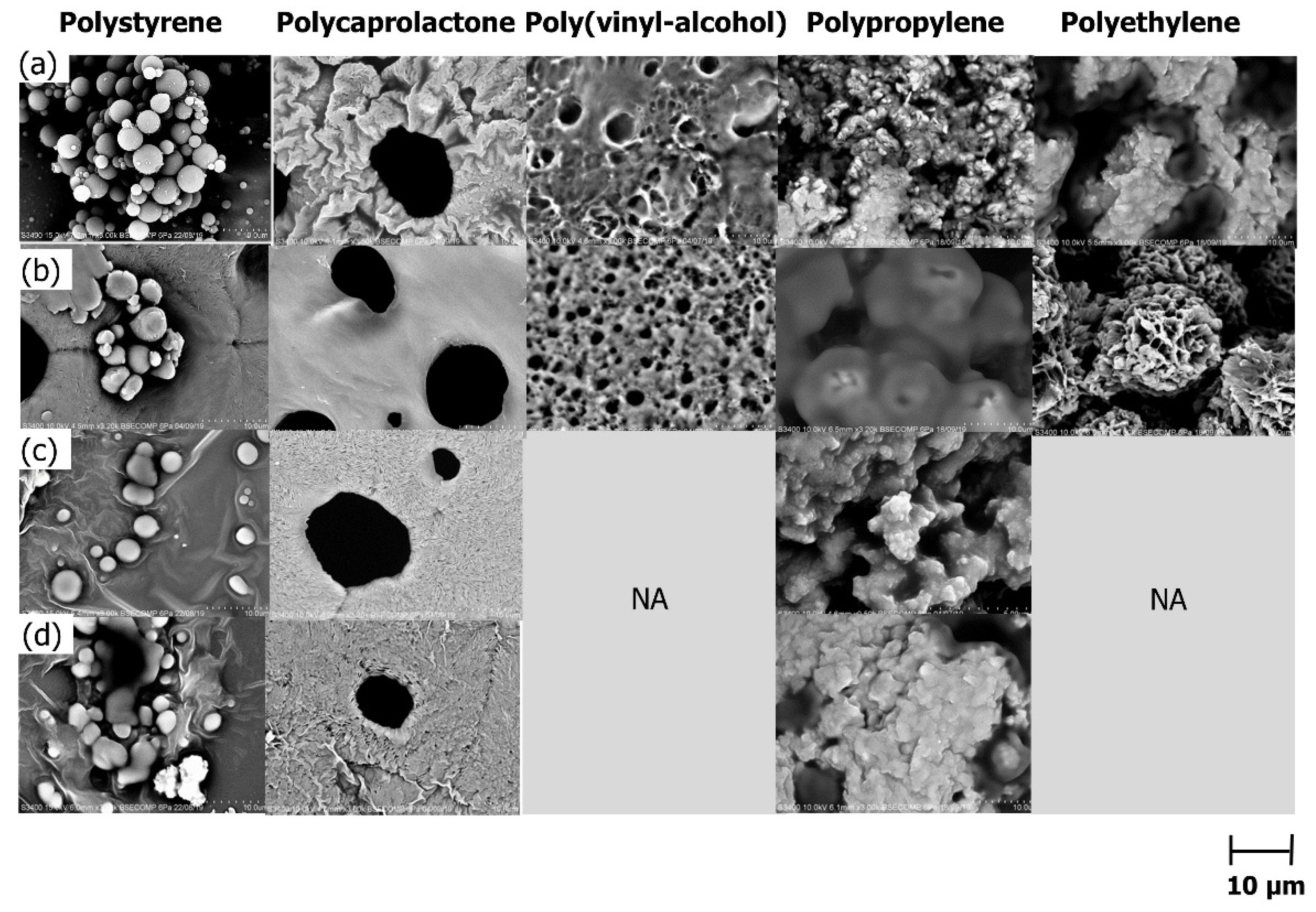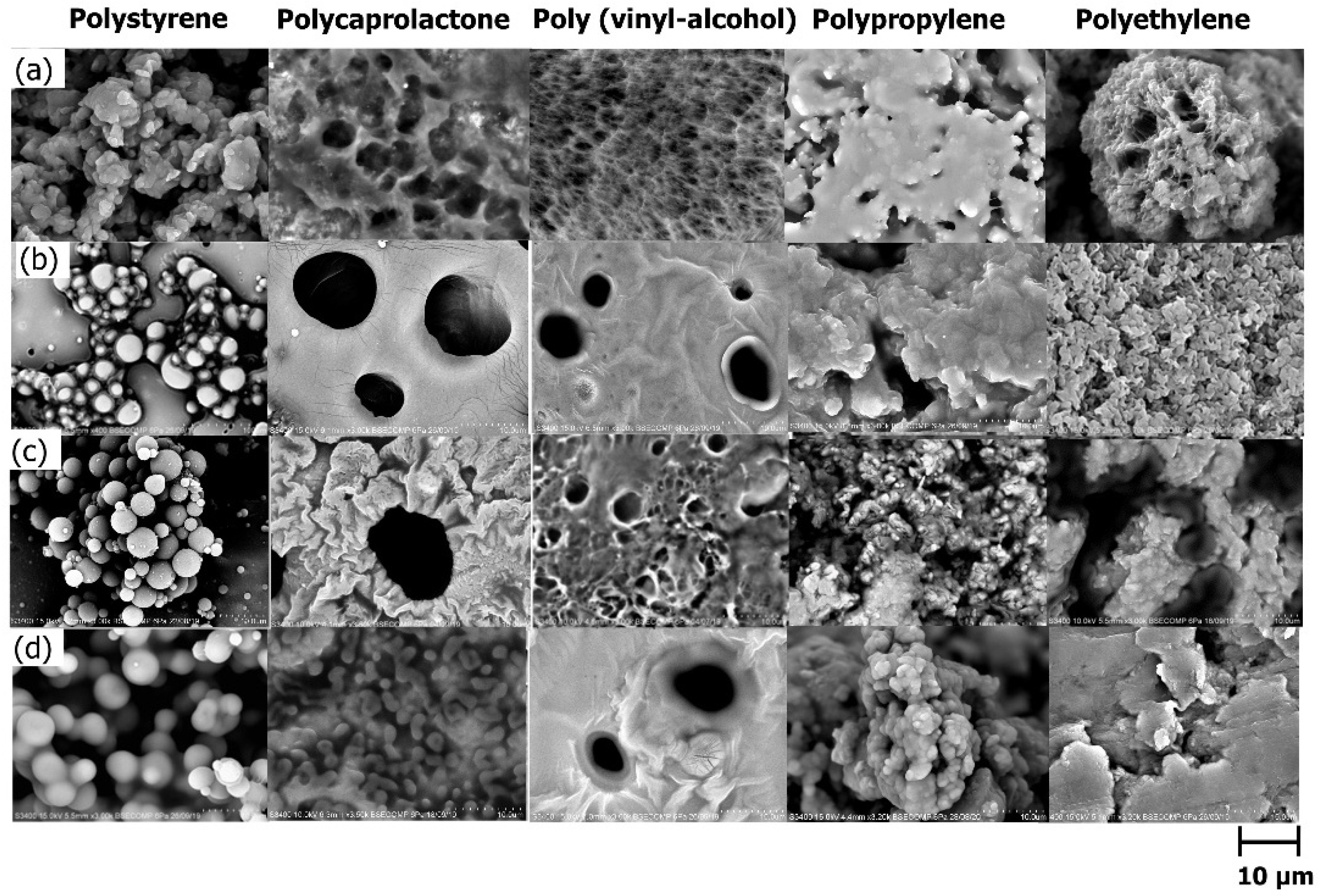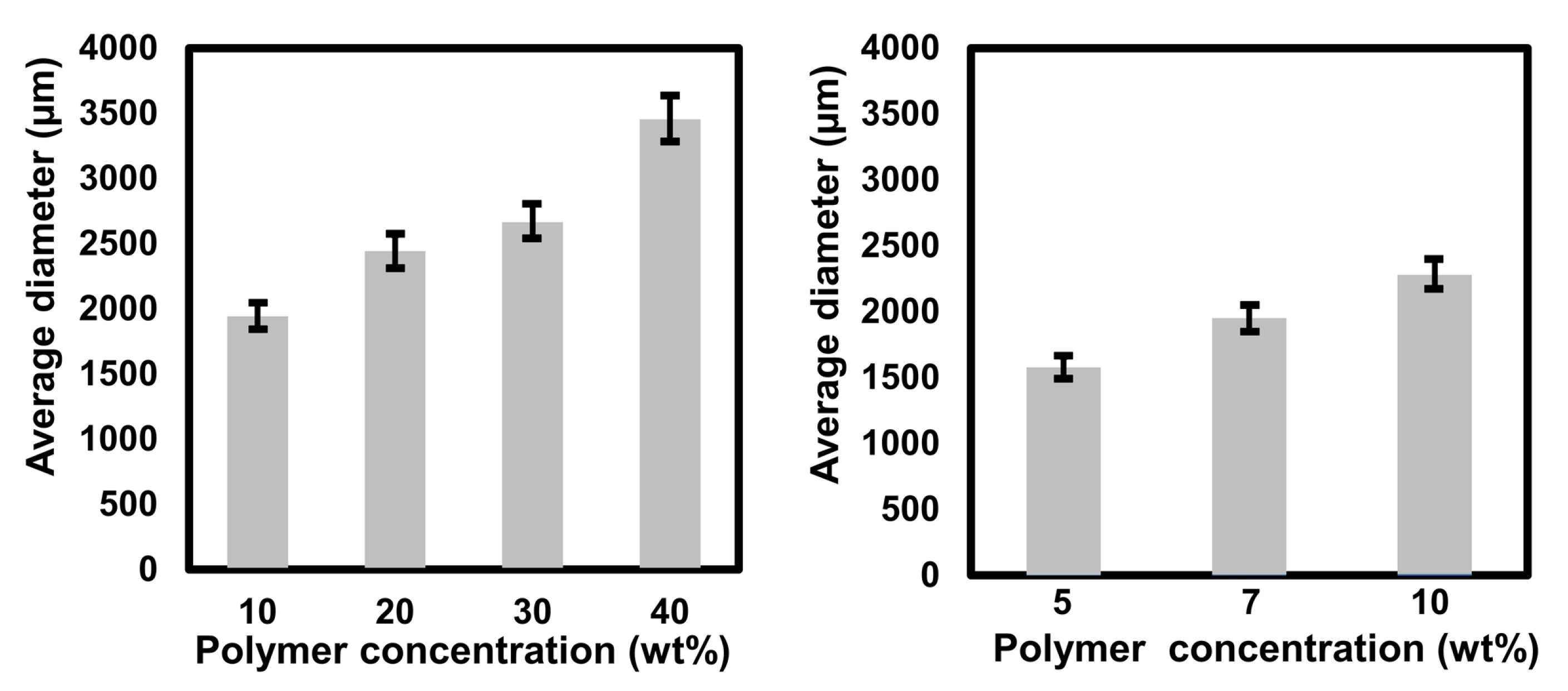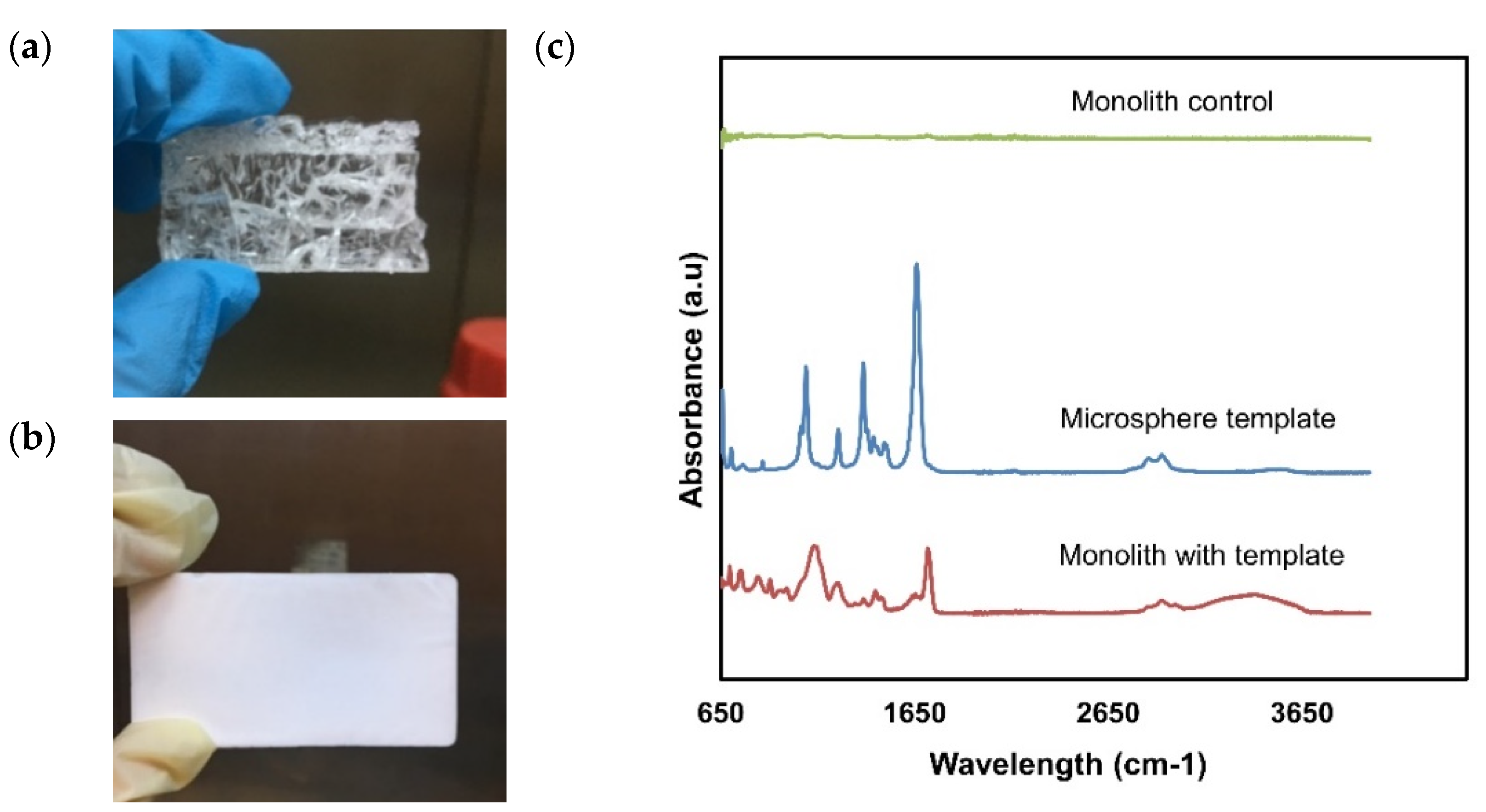Synthesis and Characterization of Polymeric Microspheres Template for a Homogeneous and Porous Monolith
Abstract
:1. Introduction
2. Materials and Methods
2.1. Materials
2.2. Synthesis of Polymeric Microspheres Template
2.3. Synthesis of Microsphere-Templated Monolith
2.4. Removal of Microspheres Template from Monolith
2.5. Characterization of Microspheres Template and Monoliths
3. Results and Discussion
3.1. Synthesis of Polymeric Microsphere Particles
3.1.1. Effect of Type of Polymer
3.1.2. Effect of Polymer Concentration
3.1.3. Effect of Surfactant Concentration
3.1.4. Effect of Polymer and Surfactant Concentration on Particle Size
3.2. Synthesis of Microsphere-Templated Porous Monolith
3.3. Effect of Microsphere Template on Pore Formation
3.4. Effect of Microspheres Template on Monolith Thermal Stability
4. Conclusions
Author Contributions
Funding
Institutional Review Board Statement
Informed Consent Statement
Data Availability Statement
Conflicts of Interest
Abbreviations
| TGA | Thermogravimetric analysis |
| nm | Nanometre |
| µm | Micrometre |
| EDMA | Ethylene glycol dimethacrylate |
| GMA | Glycidyl methacrylate |
| AIBN | Azobisisobutyronitrile |
| DMF | Dimethylformamide |
| SEM | Scanning Electron Microscopy |
| DLS | Dynamic light scattering |
| PMMA | Polymethacrylate monolith |
| FTIR | Fourier transform infrared |
| Rpm | Revolutions per minute |
| Mg | Milligram |
| Ml | Millilitre |
| Min | Minute |
| µL | Microlitre |
| (cm−1) | Wavelength Per unit distance |
References
- Galarneau, A.; Sachse, A.; Said, B.; Pelisson, C.-H.; Boscaro, P.; Brun, N.; Courtheoux, L.; Olivi-Tran, N.; Coasne, B.; Fajula, F. Hierarchical porous silica monoliths: A novel class of microreactors for process intensification in catalysis and adsorption. Comptes Rendus Chim. 2016, 19, 231–247. [Google Scholar] [CrossRef]
- Usman, M.A.; Khan, A.Y. Candle soot particles-modified macroporous monoliths for efficient separation of floating oil/water and stable emulsions. Colloids Surf. A Physicochem. Eng. Asp. 2021, 619, 126492. [Google Scholar] [CrossRef]
- Dong, X.; Yang, Z.; Wu, X.; Luo, Y.; Chen, T.; Li, M.; Hu, N.; Zhang, Y. Densely-stacked N-doped porous carbon monolith derived from sucrose for high-volumetric energy storages. Electrochim. Acta 2017, 251, 263–269. [Google Scholar] [CrossRef]
- Fu, C.; Deng, C.; Zhou, F.; Yi, D.; Zhang, Y.; Wang, X.; Tang, Y.; Wang, Y. Hierarchically porous graphitic carbon membrane with homogeneously encapsulated metallic nanoparticles as monolith electrodes for high-performance electrocatalysis and sensing. J. Colloid Interface Sci. 2020, 570, 223–231. [Google Scholar] [CrossRef] [PubMed]
- Acquah, C.; Danquah, M.K.; Moy, C.K.S.; Anwar, M.; Ongkudon, C.M. Parametric investigation of polymethacrylate monolith synthesis and stability via thermogravimetric characterisation. Asia Pac. J. Chem. Eng. 2017, 12, 352–364. [Google Scholar] [CrossRef]
- Díaz-Bao, M.; Barreiro, R.; Miranda, J.M.; Cepeda, A.; Regal, P. Recent Advances and Uses of Monolithic Columns for the Analysis of Residues and Contaminants in Food. Chromatography 2015, 2, 79–95. [Google Scholar] [CrossRef] [Green Version]
- Staniak, M.; Wójciak, M.; Sowa, I.; Tyszczuk-Rotko, K.; Strzemski, M.; Dresler, S.; Myśliński, W. Silica-Based Monolithic Columns as a Tool in HPLC—An Overview of Application in Analysis of Active Compounds in Biological Samples. Molecules 2020, 25, 3149. [Google Scholar] [CrossRef] [PubMed]
- Li, Y.; Zhang, Z.; Ge, B.; Men, X.; Xue, Q. One-pot, template-free synthesis of a robust superhydrophobic polymer monolith with an adjustable hierarchical porous structure. Green Chem. 2016, 18, 5266–5272. [Google Scholar] [CrossRef]
- Lyu, Y.; Asoh, T.-A.; Uyama, H. Hierarchical silica monolith prepared using cellulose monolith as template. Polym. Degrad. Stab. 2020, 177, 109164. [Google Scholar] [CrossRef]
- Kamin, Z.; Abdulrahim, N.; Misson, M.; Chiam, C.K.; Sarbatly, R.; Krishnaiah, D.; Bono, A. Use of melt blown polypropylene nanofiber templates to obtain homogenous pore channels in glycidyl methacrylate/ethyl dimethacrylate-based monoliths. Chem. Eng. Commun. 2021, 208, 661–672. [Google Scholar] [CrossRef]
- Mohamed, M.H.; Wilson, L.D. Porous Copolymer Resins: Tuning Pore Structure and Surface Area with Non Reactive Porogens. Nanomaterials 2012, 2, 163–186. [Google Scholar] [CrossRef] [Green Version]
- Tan, Q.; Li, S.; Ren, J.; Chen, C. Fabrication of porous scaffolds with a controllable microstructure and mechanical properties by porogen fusion technique. Int. J. Mol. Sci. 2011, 12, 890–904. [Google Scholar] [CrossRef]
- Marcos-Hernández, M.; Villagrán, D. 11—Mesoporous Composite Nanomaterials for Dye Removal and Other Applications. In Composite Nanoadsorbents; Kyzas, G.Z., Mitropoulos, A.C., Eds.; Elsevier: Amsterdam, The Netherlands, 2019; pp. 265–293. [Google Scholar]
- Xie, Y.; Kocaefe, D.; Chen, C.; Kocaefe, Y. Review of Research on Template Methods in Preparation of Nanomaterials. J. Nanomater. 2016, 2016, 2302595. [Google Scholar] [CrossRef] [Green Version]
- Ali, S.I. Colloidal Templating: A Route towards Controlled Synthesis of Functional Polymeric Nanoparticles; Technische Universiteit Eindhoven: Eindhoven, The Netherlands, 2010. [Google Scholar]
- Zhao, F.; Zhang, H.; Wu, Y.; Wang, D.; Zhang, Y. Preparation and Performance Evaluation of Polymeric Microspheres Used for Profile Control of Low-Permeability Reservoirs. J. Chem. 2020, 2020, 5279608. [Google Scholar] [CrossRef]
- Kemala, T.; Budianto, E.; Soegiyono, B. Preparation and characterization of microspheres based on blend of poly(lactic acid) and poly(ε-caprolactone) with poly(vinyl alcohol) as emulsifier. Arab. J. Chem. 2012, 5, 103–108. [Google Scholar] [CrossRef] [Green Version]
- Ghosh Dastidar, D.; Saha, S.; Chowdhury, M. Porous microspheres: Synthesis, characterisation and applications in pharmaceutical & medical fields. Int. J. Pharm. 2018, 548, 34–48. [Google Scholar] [CrossRef]
- Maciejewska, M.; Gawdzik, B.; Rogulska, M. Regular Polymeric Microspheres with Highly Developed Internal Structure and Remarkable Thermal Stability. Materials 2021, 14, 2240. [Google Scholar] [CrossRef]
- Gorsd, M.N.; Blanco, M.N.; Pizzio, L.R. Synthesis of Polystyrene Microspheres to be Used as Template in the Preparation of Hollow Spherical Materials: Study of the Operative Variables. Procedia Mater. Sci. 2012, 1, 432–438. [Google Scholar] [CrossRef] [Green Version]
- Parisi, O.I.; Curcio, M.; Puoci, F. Polymer Chemistry and Synthetic Polymers. In Advanced Polymers in Medicine; Puoci, F., Ed.; Springer International Publishing: Berlin/Heidelberg, Germany, 2015; pp. 1–31. [Google Scholar]
- Reddy, M.S.B.; Ponnamma, D.; Choudhary, R.; Sadasivuni, K.K. A Comparative Review of Natural and Synthetic Biopolymer Composite Scaffolds. Polymers 2021, 13, 1105. [Google Scholar] [CrossRef]
- Lin, T.-C.; Yang, K.-C.; Georgopanos, P.; Avgeropoulos, A.; Ho, R.-M. Gyroid-structured nanoporous polymer monolith from PDMS-containing block copolymers for templated synthesis. Polymer 2017, 126, 360–367. [Google Scholar] [CrossRef]
- Wu, Y.; Zhou, Y.-N.; Xu, Q.-J.; Li, J.-J.; Luo, Z.-H. Porous PS- and PMMA-based polymeric monoliths prepared by PEO-PS block copolymers stabilized High internal phase emulsion templates. Mater. Today Commun. 2021, 26, 101962. [Google Scholar] [CrossRef]
- Agrawal, H.; Joshi, R.; Gupta, M. Optimization of pearl millet-derived bioactive peptide microspheres with double emulsion solvent evaporation technique and its release characterization. Food Struct. 2021, 29, 100200. [Google Scholar] [CrossRef]
- Saralidze, K.; Koole, L.H.; Knetsch, M.L.W. Polymeric Microspheres for Medical Applications. Materials 2010, 3, 3537–3564. [Google Scholar] [CrossRef] [Green Version]
- Esfandyari-Manesh, M.; Javanbakht, M.; Shahmoradi, E.; Dinarvand, R.; Atyabi, F. The control of morphological and size properties of carbamazepine-imprinted microspheres and nanospheres under different synthesis conditions. J. Mater. Res. 2013, 28, 2677–2686. [Google Scholar] [CrossRef]
- Zhao, H.; Yin, F.; Zhang, L.; Zhao, G.; Xu, X. Synthesis of Polystyrene Template and Its Inverse Structure. Asian J. Chem. 2013, 25, 4498–4500. [Google Scholar] [CrossRef]
- Chan, Y.W.; Kansil, T.; Ongkudon, C.M. Analytical and preparative polymethacrylate monolith fabrication: Effect of porogen content and column size on pore morphology. Colloid Polym. Sci. 2017, 295, 2373–2382. [Google Scholar] [CrossRef]
- Pérez, N.; Olaizola, S. Fabrication of 2D Silver Nanostructures from a Polystyrene Opal; SPIE: San Diego, CA, USA, 2006; Volume 6321. [Google Scholar]
- Miller-Chou, B.A.; Koenig, J.L. A review of polymer dissolution. Prog. Polym. Sci. 2003, 28, 1223–1270. [Google Scholar] [CrossRef] [Green Version]
- Kaity, S.; Maiti, S.; Ghosh, A.K.; Pal, D.; Ghosh, A.; Banerjee, S. Microsponges: A novel strategy for drug delivery system. J. Adv. Pharm. Technol. Res. 2010, 1, 283–290. [Google Scholar] [CrossRef] [Green Version]
- Johansen, A.; Schæfer, T. Effects of interactions between powder particle size and binder viscosity on agglomerate growth mechanisms in a high shear mixer. Eur. J. Pharm. Sci. 2001, 12, 297–309. [Google Scholar] [CrossRef]
- Shahzad, K.; Aeken, W.V.; Mottaghi, M.; Kamyab, V.K.; Kuhn, S. Aggregation and clogging phenomena of rigid microparticles in microfluidics. Microfluid. Nanofluidics 2018, 22, 104. [Google Scholar] [CrossRef] [Green Version]
- Wang, J.; Zhu, H.; Li, B.-G.; Zhu, S. Interconnected Porous Monolith Prepared via UiO-66 Stabilized Pickering High Internal Phase Emulsion Template. Chem. Eur. J. 2018, 24, 16426–16431. [Google Scholar] [CrossRef]
- Ifijen, I.H.; Ikhuoria, E.U. Monodisperse Polystyrene Microspheres: Studies on the Effects of Reaction Parameters on Particle Diameter and Colloidal Stability. Tanzan. J. Sci. 2020, 46, 19–30. [Google Scholar]
- Francis, L.; Meng, D.; Knowles, J.; Keshavarz, T.; Boccaccini, A.R.; Roy, I. Controlled Delivery of Gentamicin Using Poly(3-hydroxybutyrate) Microspheres. Int. J. Mol. Sci. 2011, 12, 4294–4314. [Google Scholar] [CrossRef]
- Hoa, L.T.M.; Chi, N.T.; Nguyen, L.H.; Chien, D.M. Preparation and characterisation of nanoparticles containing ketoprofen and acrylic polymers prepared by emulsion solvent evaporation method. J. Exp. Nanosci. 2012, 7, 189–197. [Google Scholar] [CrossRef]
- Liu, D.; Pan, J.; Tang, J.; Lian, N. Preparation of polymethacrylate monolith modified with cysteine for the determination of Cr(iii) ions. RSC Adv. 2018, 8, 24906–24912. [Google Scholar] [CrossRef] [Green Version]
- Yusuf, K.; Badjah-Hadj-Ahmed, A.Y.; Aqel, A.; ALOthman, Z.A. Monolithic metal-organic framework MIL-53(Al)-polymethacrylate composite column for the reversed-phase capillary liquid chromatography separation of small aromatics. J. Sep. Sci. 2016, 39, 880–888. [Google Scholar] [CrossRef] [PubMed]







Publisher’s Note: MDPI stays neutral with regard to jurisdictional claims in published maps and institutional affiliations. |
© 2021 by the authors. Licensee MDPI, Basel, Switzerland. This article is an open access article distributed under the terms and conditions of the Creative Commons Attribution (CC BY) license (https://creativecommons.org/licenses/by/4.0/).
Share and Cite
Ibadat, N.F.; Ongkudon, C.M.; Saallah, S.; Misson, M. Synthesis and Characterization of Polymeric Microspheres Template for a Homogeneous and Porous Monolith. Polymers 2021, 13, 3639. https://doi.org/10.3390/polym13213639
Ibadat NF, Ongkudon CM, Saallah S, Misson M. Synthesis and Characterization of Polymeric Microspheres Template for a Homogeneous and Porous Monolith. Polymers. 2021; 13(21):3639. https://doi.org/10.3390/polym13213639
Chicago/Turabian StyleIbadat, Nur Faezah, Clarence M. Ongkudon, Suryani Saallah, and Mailin Misson. 2021. "Synthesis and Characterization of Polymeric Microspheres Template for a Homogeneous and Porous Monolith" Polymers 13, no. 21: 3639. https://doi.org/10.3390/polym13213639
APA StyleIbadat, N. F., Ongkudon, C. M., Saallah, S., & Misson, M. (2021). Synthesis and Characterization of Polymeric Microspheres Template for a Homogeneous and Porous Monolith. Polymers, 13(21), 3639. https://doi.org/10.3390/polym13213639





